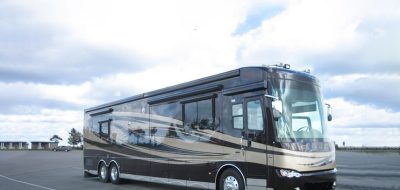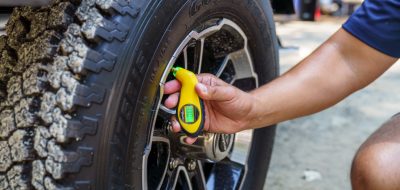We often talk about the importance of checking the inflation pressure in tires, but is your tire pressure gauge giving you accurate information? After writing my article titled, “Take the Visual RV Tire Test” I received several emails regarding the accuracy of tire pressure gauges.
One person commented, “I understand that tire pressure in an RV is crucial and can cause serious problems if not inflated correctly. Well, the problem is this, how do you know if the tire gauge is accurate? I have seen two tire gauges show as much as 16 psi difference on the same tire. Is there a recommendation as to which tire gauges are the most accurate?”
What’s funny about this is for many years, as a Maintenance Warrant Officer in the Army, I was responsible for tool calibration programs. Certain tools required regular calibration to ensure accuracy. I use a quality tire pressure gauge, but after reading this question realized that after several years of using this gauge I have never had it checked for accuracy.
Many of the really inexpensive gauges ($5) you can purchase can’t be calibrated, and if the reading is inaccurate the gauge is worthless. This is why you should spend a little more ($15-$25) and get a quality pressure gauge that can be calibrated. I am a real believer in the old saying; you get what you pay for.
If you have any doubt about the accuracy of your tire pressure gauge, there are a couple things you can do to check it.
1) You can check the air pressure in a tire with the gauge in question and then check the same tire with another gauge. If there is a significant difference in the readings (4 or more psi) between the two gauges one or both gauges may be inaccurate. If both gauges read within 1 to 2 psi of each other the gauges are more than likely accurate.
2) If you want a more precise method for checking the accuracy take the gauge to a local tire dealer or fleet truck maintenance facility and ask them to check it using a master gauge. A master gauge is a gauge that is certified to be accurate. But I caution you there are lots of tire dealers who don’t have their own tire pressure gauges calibrated.
Note: Don’t depend on pressure gauges at gas stations to be accurate. These are usually abused and neglected, raising concern over accuracy.
There are several different types of pressure gauges available on the market. One important thing to keep in mind is the pressure the gauge is rated for. Most automobile tires are inflated to around 32 psi, so a 0 to 60 psi gauge is sufficient. On the other hand some motorhome tires are inflated to 100 or more psi. It is important, for accuracy and to prevent damage to the gauge, that you get the right gauge for the job. A general rule of thumb is to find a gauge that can read double what the inflation pressure is set at. This isn’t always possible especially with tires inflated to 100 psi, so find a gauge rated for high pressure, like 160 psi.
Possibly the most common type of pressure gauge is the plunge or pencil type. Some of these are calibrated and some of the cheaper ones are not. As a general rule a common plunge type gauge you would purchase will be accurate to + or – 3 psi when it is new. The accuracy of these type gauges are also affected by temperature, humidity and altitude.
Note: Always check the tire pressure when the tires are cold, before traveling. If you check the tires when they are hot you will get a false (higher) reading and if you let air out of the tires they can be seriously underinflated when they are cold.
Like everything else these days’ things are switching from analog to digital. Analog tire pressure gauges were the standard for many years, but advancements in digital technology have improved on that standard. Analog dial gauges are about as accurate as the quality pencil type gauges. In numerous tests comparing different type gauges digital gauges were the most accurate tested.
Regardless of the type of gauge you choose there are high quality and low quality gauges available. Buying a cheap digital gauge would be the same as buying a cheap pencil type gauge. Here are a few things to keep in mind when it comes to tire pressure gauges.
1) Spend a few more dollars and get a quality pressure gauge.
2) If the gauge will be used for checking dual wheels on a motorhome the chuck end of the gauge should have a dual foot design to make the job much easier.
3) Always select a gauge rated higher than the inflation pressure of the tires you are checking. Applying more pressure than the gauge is rated for can damage the gauge and affect the accuracy. If you over-pressure a gauge have it tested for accuracy.
4) Try not to drop or jar the gauge. Store the gauge in some type of protective covering or case and in an area where it won’t be hit or damaged.
5) Periodically have the gauge tested for accuracy. At a minimum compare it to another quality gauge to see if both read the same, or close to the same pressure.
6) Most importantly, once you purchase a quality pressure gauge use it on a regular basis to check your RV and automobile tires.
Remember, properly inflated tires are safer, extend the life of the tires, improve fuel efficiency and lessen the chance of unexpected and premature tire failure.
Happy Camping,
Mark Polk






Pingback: How to Spruce up Your Dallas Car for Spring | Hance's
Pingback: Motorcycle Tools | Texas Motorcycle Accident Attorney
Kathleen Mizrahi
Very nice invention..I like to check that out to know how to used it..Thank you.
Ollie
Very useful tire pressure blog, have bookmarked for future reference.
Pingback: Check Your Tire Pressure Gauges - Page 2 - Hayabusa.oRg
Tireman9
Some comments on pressure gauges:
At a rally in Ohio in October I had the opportunity to verify 31 pressure gauges after my Tire Basics seminar.
Testing at 75 to 82 psi range against a digital 150 psi gauge that had been compared to an ISO certified gauge as accurate to +/- 0.25 psi, we learned that 5 were off by more than 5 psi including two that read over 12 psi high! The rest were within +/- 3.0 psi.
I am certain that there are a number of sufficiently accurate pressure gauges on the market. Based on personal observations I have found the majority of those that were least accurate were “pencil” type. My personal selection is Accurtire digitals.
Dan is basically correct but I have a slight different suggestion for when you discover your tires are a few psi low when you check them “cold” and do not have a compressor available, make a note of exactly how many pounds low each tire is. When you get to the service station that has air available again measure the tires and increase the now “hot” inflation by the number of pounds + 2 your calculations indicated you needed when you measured the tire cold. The next day you can then confirm the cold inflation is now correct.
I am assuming you have had your unit on scales that measures each corner of your RV separately and then had the minimum inflation needed for each tire calculated by someone that is knowledgable on how to determine the correct tire inflation needed.
Phil ( March 1) asked about compensating for ambient temp etc. If you set the “cold” inflation based on your ambient and altitude when you are ready to leave the campground you will be OK for the day. Cold inflation pressure is defined as the pressure at the prevailing atmospheric temperature.
Ron (March 2) Pressure gauges account for altitude so you do not need to adjust for altitude.
Frank ( March 2) is correct that you cannot look at your tires and tell if one is low. In my seminars I demonstrate that people are off by as much as 30 psi when they estimate tire inflation.
T&G (June) One way to check your own gauge is to get two. After confirming they are both accurate, pack one away and use it every six months or so to compare its reading against the 2nd one that you use to check your tires before each trip.
T&G
The article had some basic good suggestions but really getting down to it you need a better way of easily testing your gauge. Going to find some “Master Gauge” is not reality.
Testing your gauge is the only true way of knowing for sure and there is no way to consistently be sure you have the right pressures.
Most unfortuate…
T&G
Roger
Just to let people that are going to either FMCA GLASS rally in Mich in a couple of weeks or to the FMCA Int’l in Bowling Green in July, I am giving a talk on Tire Basics for the RV owner.
I am also offering a service to allow attendees to compare their gage against my calibrated tire gauge.
Also to Doug
I have used and checked a number of gauges made by Accutire and found them all accurate within one unit.
doug miracco
Mark, Could I please have the name of the company that sells accurate tire gauges one more time…………………thanx……………Doug miracco
Pingback: RV Tire Tips for Safer RV Trips : blog.rv.net
mike
Speaking of tire pressure… another issue is how can we check in inner tires in the rear on our Sprinter chassis. It seems impossible, even at the tire stores they are baffled with the European design.
Another pressing pressure question is = What pressure recommendations do people use – our coach manufacturer states a pressure that is 25 lbs. less than stated on the tire??
Rick
To combat the issue of accurate tire pressure I have installed a 200psi VIAIR (380C) air compressor and a digital gauge. I also have a dial gauge that I use to compare to the digital to get a “indication” of gauge accuracy. The VIAIR air compressor is very small and will need a pressure switch and relay installed. It has no tank and will fill up a G670 Goodyear tire 10psi in minutes. I also installed an Intermatic spring switch in series with the relay winding ground to turn the unit on and off. This prevents the compressor from being left on accidentally. Hope this helps!
DAN
FRANK,
before installing the tire pressure and temp monitor system, i used to use a billy club to strike the tires and listen for a different tone at every stop (thumping). i still use an infrared temperature gauge to monitor tire and brake temperatures often, but not at every stop.
my TST TRUCK system works well and at about $300 imoh it is a great value.
John P.
I use a 120volt tire inflator (cost about 40 bucks) it takes a few minutes to top off 22 inch tires but it works.
Frank
I am a retired aircraft mechanic and can tell you first hand that tire psi gagues can’t be trusted, most are inacurate,or soon become inacurate. I was going to install the valve stem cap pressure monitors, they are not worth the money in my opinion, they will let you know if you have a significant loss, I imagine that the built in tire psi monitering systems work about as well, ok for compairing tires but not to be trusted for accurate monitoring to the pound. I try to keep my tires over inflated by two pounds never exceeding the sidewall max psi. I have a small compressor that I use at home to inflate my tires, on the road to top off a tire I use a battery powered inflator, it works to top off a tire, the biggest drawback is that it takes a few minutes to add a pound. The other thing that I have noticed is that on a colder day the gage if kept in the glove compartment will be inacurate from the temperature till you warm it up. I use three gages and keep one in each vehicle, occasionally I compare them to see if they agree. I do not trust tire dealers gages, they can be as bad as what you use, I seriously doubt that they have professional calibration check their equipment. If you use one with a dial if it does not return to 0 then it probally is not accurate. Go to the major tire manufactures webb sights for straight information on inflating and care of tires. One thing that you should do is look at your tires for comparitive inflation, assuming that they start out properly inflated if one has a serious air loss with practice you might be able to see it, look from the front or back and compair the tires on the same axle, any doubt check with a gague. Look at them before checking inflation and see if you can spot a low one by looking at and compairing the sidewall from the front or back, not the side. With practice you can pick out a low tire that could cause tire failure from under inflation, while you are at it look for fluid loss from the car or other visual signs of a problem like cuts on the tires or a nail, the more that you practice looking the better you will get at spotting stuff that is different and problematic
Don.....T
I ditto Tom Becher’s comment on the Huskey air- comp from Home Depot it works very well and is resonable in cost.
Drew Mueller
There is lots of good info. here contributed by all. I have a real problem however with the practice of most motorhome manufacturers of class c and a types. Very few install valve extentions that makes it possible to check your tires. There needs to be something in place requiring builders to install these devices prior to delivery- checking your tires is basic safety and should not be an option. I’ve communicated this to my congressman and representatives, as well as some manufacturers- no response to date. You’d think after the Bridgestone/Firestone/Ford mess some time ago- that people would be smarter about this. Sadly, it may take several fatal accidents for people to wake up.
Jerry Shea
I always check my tires so I was surprised when I had an oil change at Camping World in La Mesa two days ago and they guy says all your tires are down by 20psi?? No way, I just checked them that morning. I got out my gauge (that hooks to the air compressor) and it read 110. The guys gauge read 100? I asked him to go get another gauge. That one read 80? I got my pencil gauge and it registered 100.
So — just what is the tire pressure and which one is right? Since his gauge and the pencil gauge both said 100, then that means when I put air in the tires with my compressor with the tire gauge I use, I need to go to 110 and then check it with the pencil gauge to see if it reads 100. Next time I am near a tire shop I will check these out again. Feel sorry for anyone that had their tires checked by the guy using the gauge that registered 80.
Phil Schoner
We all know to check our tires cold, not after being on the road for even a few miles. However, no one tells you what the ambient temperature (let alone altitude) should be at time of testing. Tires checked at 40 degrees F. will be at least 10 psi lower than when tested at 75 degrees F. So when your tire chart tells you to inflate your tires to 110 psi, what temperature are they assuming?
Phil Schoner
Ian McKee
I use PressurePro tire sensors andd a readout device in my truck (I drive a fifth wheel). When I start my truck I can read the tire pressure in all trailer and truck tires (12) at one time and can monitor them while driving. Tire gauges are stone age!
Get with the program!
DAN
i installed the TST TRUCK wireless tire pressure and temperature monitor system.
now i get a continuous readout of both tire pressure and temperature on the dash display.
it cost <$300.
for more info, check out my entries on the IRV2 forum. my login is DAN L. the TST website also has good info.
Dalton Tamney
Thanks to everyone for your comments. All gave me some ideas to consider which I will. The Campbell Hausfeld sounds promising. Thanks again.
Dan Rambow
Regarding Dalton’s concerns, tire pressure is not rocket science. A few pounds one way or the other is not critical (ok, ok, I do try to get all my tires with-in 1/2 pound of each other). But common sense here can apply.
If you check your tires cold, and they are say 10 pounds low, then drive to a gas station with a compressor. The tires will have heated some, and now say the pressure is right on the money (10 pounds higher than when they were cold). Common sense says, put in 10 more pounds of air, but I would say run it up about 8 pounds because you will cool the hot air some with the introduction of the new cool air.
Then next time the tires are cold, check the pressure again, and see how close you are. And adjust your procedure accordingly. Not exact, but it should be close.
Thomas Becher
I check my tires b4 moving, and I carry in the basement a Husky air comp. from Home Depot which is oiless and 130#. Its about 14″ wide 10″ thick and about 20″ high
Cost about $90. Came with about 20 ft of hose and a bunch of acess. including a digital guage. It takes the worry out of low pressure starting out or where to get air. Also use it at the campsite for bikes. You’d be surprised how many people ask for air when they see mine.
Cliff Thew
Regarding the previous post questioning the capability of pumping up tires at the camp site, I would point you to one of several 12 volt pumps that are integrated into a package with a 12 volt rechargable battery. I have settled on the Campbell Hausfeld which can deliver up to 200psi. It has a 120volt rechargeing module and can hold a charge for easily a full camping season. Noting that here in Wisconsin our camping season is only 17 days long……
Serially, this is a nice little unit that delivers good capability at a reasonable price. And at about 6 pounds, 9″X6″X3″ doesn’t require a lot of space either. There are larger units that offer the side benefit of around 400ah that can jump start most tow vehicles as well.
Dalton Tamney
I am concerned (almost to the point of paranoia) about tire pressure. The tires are supposed to be checked cold. However getting either my trailer or motorhome to a place where I can pump them up if needed is becoming a problem. Many service stations around here are removing their tire compressors so I am having to drive quite a distance to find somewhere where I can add air to my tires. This will heat them up and of course cause the gauge to read high. How can I ensure that I have the right pressure in my tires under these circumstances? As I see it my only recourse is to buy a portable air compressor but that presents other problems. The little 12 volt ones are useless for anything over 20 lbs and the larger ones with the air tank either run on 120V or have a small gas engine. Or I could haul my generator out to my trailer along with the compressor. This is starting to get a little out of hand. Any advice?
William Whitcomb
Good article. I am one who a lot of times buys the least expensive ones and am glad to know there is a great difference in gauges. Also, #6 is probably the most important one, expecially the words “USE IT”. What good is having a tool if it is not used.
john Christman
On the other hand spend the money (just like you should for your tires and brakes–after all it is YOUR safety that we’re talking about) and buy a good quality digital tire gauge and you won’t be having to keep buying a new gauge every few years.
About ten years ago I finally decided to buy a Napa digital gauge that seems to have a “forever” battery in it and it measures half pounds all the way up to 160 psi. I check it with two tire dealers annually to be sure it is reading correctly. It has never lost it’s calibration. Now granted, I paid $75 for it back in 1999, but would buy it again (at most any price) if needed. It comes with a foot long flexible hose and large readouts.